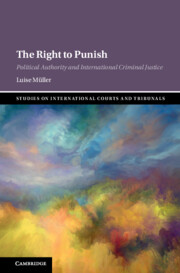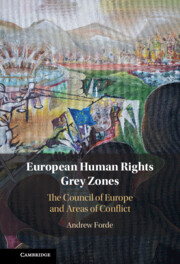2382 results
2 - Cleaning Our Messes
- from Part I - Geographies of Environmental Violence
-
-
- Book:
- Exploring Environmental Violence
- Print publication:
- 30 June 2024, pp 50-62
-
- Chapter
-
- You have access
- Open access
- HTML
- Export citation
5 - The Right World
-
- Book:
- World of the Right
- Print publication:
- 27 June 2024, pp 144-182
-
- Chapter
- Export citation
Chapter 13 - A Legal Perspective on Judicial Remedies to Respond to Young People’s Climate Distress
- from Part II - Multidisciplinary Perspectives on Youth Climate Distress
-
-
- Book:
- Climate Change and Youth Mental Health
- Print publication:
- 13 June 2024, pp 251-268
-
- Chapter
- Export citation
11 - The International Criminal Court
-
- Book:
- International Organizations
- Published online:
- 17 May 2024
- Print publication:
- 06 June 2024, pp 248-268
-
- Chapter
- Export citation
16 - Tensions Mount
- from Part III - Decline
-
- Book:
- To Run the World
- Published online:
- 30 May 2024
- Print publication:
- 30 May 2024, pp 452-473
-
- Chapter
- Export citation
Regime of torture: Guantánamo Bay’s ongoing detention and prosecutions of the CIA’s Rendition, Detention, and Interrogation prisoners
-
- Journal:
- Review of International Studies , First View
- Published online by Cambridge University Press:
- 30 May 2024, pp. 1-20
-
- Article
- Export citation
3 - The Authority to Punish
-
- Book:
- The Right to Punish
- Published online:
- 16 May 2024
- Print publication:
- 23 May 2024, pp 47-74
-
- Chapter
- Export citation
Consent and Inclusion of People Living with Dementia (PLWD) in Research: Establishing a Canadian Agenda for Inclusive Rights-Based Practices
-
- Journal:
- Canadian Journal on Aging / La Revue canadienne du vieillissement , First View
- Published online by Cambridge University Press:
- 20 May 2024, pp. 1-8
-
- Article
-
- You have access
- Open access
- HTML
- Export citation

The Right to Punish
- Political Authority and International Criminal Justice
-
- Published online:
- 16 May 2024
- Print publication:
- 23 May 2024
John Perceval's account of his psychosis, 1830–1832
-
- Journal:
- BJPsych Advances , FirstView
- Published online by Cambridge University Press:
- 16 May 2024, pp. 1-4
-
- Article
-
- You have access
- Open access
- HTML
- Export citation
Implementation of the World Health Organization's QualityRights initiative in Ghana: an overview
-
- Journal:
- BJPsych Open / Volume 10 / Issue 3 / May 2024
- Published online by Cambridge University Press:
- 13 May 2024, e111
-
- Article
-
- You have access
- Open access
- HTML
- Export citation
Framing and prosecutorial discretion: evidence from Brazil
-
- Journal:
- Law & Society Review / Volume 58 / Issue 2 / June 2024
- Published online by Cambridge University Press:
- 13 May 2024, pp. 163-191
- Print publication:
- June 2024
-
- Article
-
- You have access
- Open access
- HTML
- Export citation
Hope in hardship: charting a new course for mental health in Afghanistan
-
- Journal:
- BJPsych Open / Volume 10 / Issue 3 / May 2024
- Published online by Cambridge University Press:
- 07 May 2024, e102
-
- Article
-
- You have access
- Open access
- HTML
- Export citation
14 - Australia and the International Human Rights Regime1
- from Part III - Issues
-
-
- Book:
- Australia in World Affairs 1996–2000
- Published online:
- 04 May 2024, pp 178-192
-
- Chapter
- Export citation
4 - Chambres Spécialisées: From Legalism to Lawfare
- from Part III - The Emergence of Lawfare
-
- Book:
- The Violence of Law
- Published online:
- 30 April 2024
- Print publication:
- 02 May 2024, pp 142-192
-
- Chapter
- Export citation
The U.S. Military: A Reluctant Humanitarian
- Part of
-
- Journal:
- Modern American History / Volume 7 / Issue 1 / March 2024
- Published online by Cambridge University Press:
- 26 April 2024, pp. 109-113
-
- Article
-
- You have access
- Open access
- HTML
- Export citation
In Fairness to Nottebohm: Nationality in an Age of Globalization
-
- Journal:
- Asian Journal of International Law , First View
- Published online by Cambridge University Press:
- 25 April 2024, pp. 1-31
-
- Article
-
- You have access
- HTML
- Export citation
1 - Introduction
-
- Book:
- European Human Rights Grey Zones
- Published online:
- 18 April 2024
- Print publication:
- 25 April 2024, pp 1-19
-
- Chapter
- Export citation
Some Challenges for Moreau's Theory of Wrongful Discrimination
-
- Journal:
- Dialogue: Canadian Philosophical Review / Revue canadienne de philosophie / Volume 63 / Issue 1 / April 2024
- Published online by Cambridge University Press:
- 23 April 2024, pp. 21-29
-
- Article
-
- You have access
- Open access
- HTML
- Export citation

European Human Rights Grey Zones
- The Council of Europe and Areas of Conflict
-
- Published online:
- 18 April 2024
- Print publication:
- 25 April 2024



